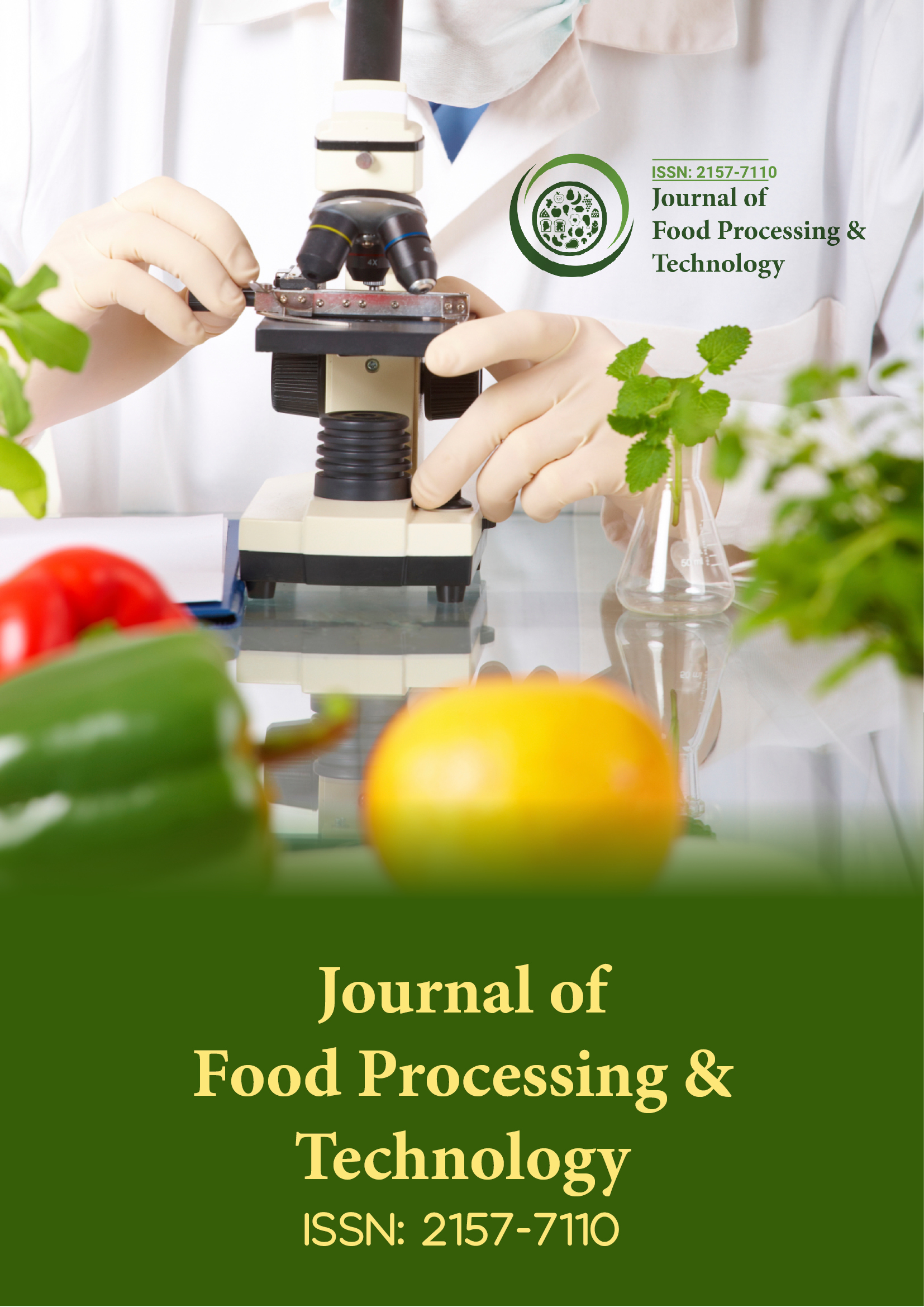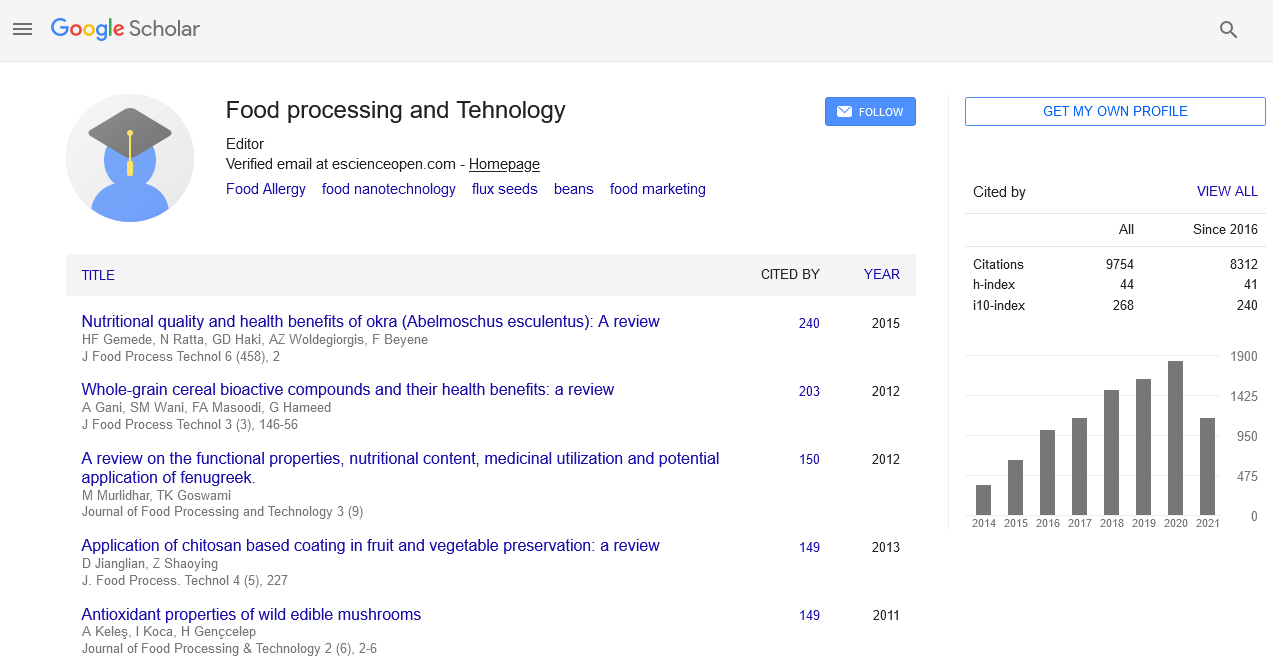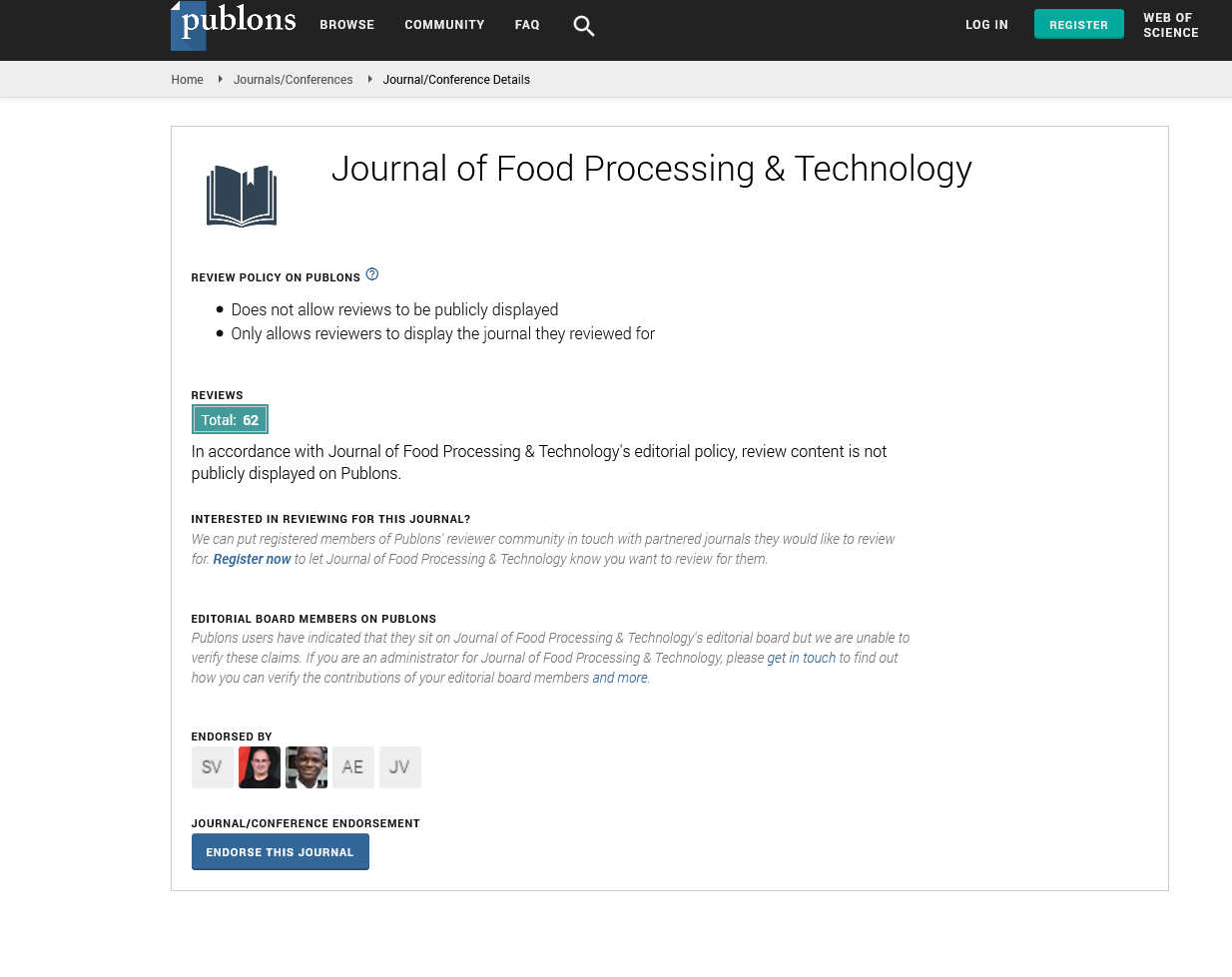Indexed In
- Genamics JournalSeek
- Academic Keys
- JournalTOCs
- China National Knowledge Infrastructure (CNKI)
- Access to Global Online Research in Agriculture (AGORA)
- Centre for Agriculture and Biosciences International (CABI)
- RefSeek
- Directory of Research Journal Indexing (DRJI)
- Hamdard University
- EBSCO A-Z
- OCLC- WorldCat
- Scholarsteer
- SWB online catalog
- Publons
- Euro Pub
- Google Scholar
Useful Links
Share This Page
Journal Flyer

Open Access Journals
- Agri and Aquaculture
- Biochemistry
- Bioinformatics & Systems Biology
- Business & Management
- Chemistry
- Clinical Sciences
- Engineering
- Food & Nutrition
- General Science
- Genetics & Molecular Biology
- Immunology & Microbiology
- Medical Sciences
- Neuroscience & Psychology
- Nursing & Health Care
- Pharmaceutical Sciences
Opinion Article - (2025) Volume 16, Issue 3
Utilization of Coffee By-Products in Sustainable Food Processing
Lucas Pereira*Received: 26-May-2025, Manuscript No. JFPT-25-29657; Editor assigned: 28-May-2025, Pre QC No. JFPT-25-29657; Reviewed: 11-Jun-2025, QC No. JFPT-25-29657; Revised: 19-Jun-2025, Manuscript No. JFPT-25-29657; Published: 25-Jun-2025, DOI: 10.35248/2157-7110.25.16.1159
Description
The coffee industry, one of the most widely consumed beverage sectors globally, generates substantial amounts of by-products during the processing of coffee beans. These by-products include coffee husks, pulp, silverskin, and spent coffee grounds. Traditionally, most of these materials have been discarded as waste or used in low-value applications such as composting, animal feed, or bioenergy production. However, with increasing global attention to sustainability, resource efficiency, and circular economy practices, there has been a growing interest in exploring these by-products as valuable raw materials for food applications and other industrial uses. Coffee husks and pulp are generated during the wet processing of coffee cherries, which involves removing the outer layers of the fruit to extract the coffee beans. These materials are rich in bioactive compounds, including dietary fiber, polyphenols, and natural antioxidants, making them attractive candidates for functional food development. The dietary fiber content, in particular, can contribute to digestive health and help in managing chronic conditions such as diabetes and cardiovascular diseases. Polyphenols and other antioxidant compounds are associated with reducing oxidative stress in the body and may have antiinflammatory and protective effects against certain diseases. Incorporating coffee husk and pulp into food products, therefore, not only reduces waste but also adds nutritional value, creating foods with enhanced health benefits.
Various applications of coffee by-products in food processing have been explored. In bakery products, such as bread, muffins, and cookies, coffee husks and pulp can be used as partial flour substitutes. Their fibrous texture improves satiety and contributes to the overall nutritional profile of the product. Similarly, cereal bars and snacks fortified with coffee by-products offer a convenient way to include dietary fiber and antioxidants in daily diets. Beverages infused with coffee husk extracts can provide a mild coffee flavor while also delivering polyphenolic compounds. Furthermore, spent coffee grounds, which remain after brewing, are a rich source of phenolic compounds that can be extracted and used in functional food formulations, such as protein bars, smoothies, and nutraceutical supplements. Beyond nutritional enhancement, coffee by-products are also being investigated for their sensory contributions, particularly as natural colorants and flavor enhancers. The inherent brown color of coffee husks and silverskin can be used as a natural coloring agent in confectionery products, chocolate-based desserts, and dairy items, reducing the need for synthetic dyes. Their mild coffee-like flavor makes them suitable for flavor enrichment, complementing chocolate, caramel, or nut-based formulations. Additionally, the fibrous nature of these byproducts allows them to function as fat replacers in bakery items, contributing to reduced-calorie products without compromising texture or mouthfeel.
While the potential of coffee by-products in the food industry is significant, food safety remains a critical consideration. Some byproducts may contain residual caffeine, which could be of concern in products targeted at children or sensitive populations. Additionally, the presence of mycotoxins, pesticides, or microbial contamination is possible if the raw materials are not handled, stored, or processed appropriately. Advances in processing technologies, including drying, fermentation, and extraction techniques, are helping to mitigate these risks. For example, controlled drying reduces microbial growth, while fermentation can enhance the bioavailability of polyphenols and other nutrients. Proper extraction methods ensure that the resulting ingredients are safe for consumption and retain functional properties. The utilization of coffee byproducts aligns with broader trends in sustainable food production and the circular economy. By diverting materials that would otherwise contribute to environmental burden, the food industry can reduce waste and promote eco-friendly practices. Additionally, the development of coffee by-product-based foods meets growing consumer demand for sustainable, plant-based, and functional products. Health-conscious and environmentally aware consumers are increasingly interested in foods that offer both nutritional benefits and reduced environmental impact, making coffee by-products a valuable resource for product innovation.
Research in this field continues to expand, exploring novel processing techniques and new product formulations. Emerging studies are investigating the synergistic effects of coffee byproducts with other functional ingredients, such as probiotics, plant proteins, and natural sweeteners, to create multifunctional foods. Moreover, collaborations between food scientists, nutritionists, and industry stakeholders are facilitating the translation of laboratory research into commercial applications, ensuring that these by-products are safely and effectively incorporated into the food supply. In conclusion, coffee byproducts represent an underutilized resource with immense potential for enhancing sustainability and nutritional value in food products. From bakery items and beverages to functional ingredients and natural colorants, these materials offer diverse applications that contribute to waste reduction and the development of health-promoting foods. With continued research, technological advancements, and attention to food safety, the integration of coffee by-products into the food chain represents a promising and innovative direction for the coffee industry and food processing sector as a whole.
Citation: Pereira L (2025). Utilization of Coffee By-Products in Sustainable Food Processing. J Food Process Technol.16: 1159.
Copyright: © 2025 Pereira L. This is an open access article distributed under the terms of the Creative Commons Attribution License, which permits unrestricted use, distribution and reproduction in any medium, provided the original author and source are credited.


